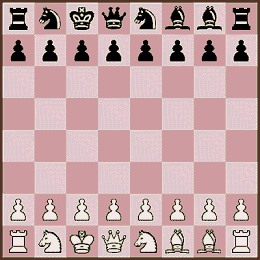

Abstract
In Chess-B normal chess rules apply, although the opening setup is different than in orthodox chess. It has been selected from the array of opening positions in Fischer Random Chess (here). Castling on the king side is performed by moving the king to the g-file. Castling on the queen side is performed by simply moving the rook to the d-file. This particular setup vouches for an interesting game.
Discussion
Fischer Random Chess, as originally conceived, brings with it certain disadvantages. In an interview Garry Kasparov says:
As for Fischer Random or similar ideas, I’m very much in favor. Let’s be very specific. Fischer Random in its purity is not such a great idea. It creates a mess at the chess board from the very beginning. Out of 960 positions, 95% are quite bad.
What I think could help, and I’ve been saying it for almost ten years, if certain positions selected by a committee of grandmasters or chess fans, I would say at least 20 positions are pretty good. They are playable and these positions could be picked up on a random basis for a whole year, or for a special tournament. They could be announced in advance, a week or two. If you want, you can play for a whole year. Even one year is not enough to come up with a comprehensive theory, but it adds a component that is very important.
Starting from scratch is wrong. It eliminates a very important element of chess beauty. When you are preparing, you are looking for strategies. You won’t do much, but at least you will be able to start in unknown territory and start working out some kind of decent strategy for games to look real. Not to have Pawns blundered at move ten or five, which happens, because the geometry is totally alien to our eyes, with new weaknesses in the position. That’s my take. (‘Chess960 (FRC)’, here)
In FRC, certain positions are too advantageous to the white player. On the other hand, other opening positions won’t allow white to develop an initiative. Comparatively, the Fide-chess position is ideal in this sense. It is balanced, yet white can try and seize the initiative already in the opening. Black has to play careful to maintain the balance, which vouches for an interesting game.
Another factor which speaks against Chess960 is that opening studies will become virtually meaningless. Chess players take great pleasure in developing their own secret variants. They study openings with the scientific method. As opening and middle game connect, these studies are important for a deepened understanding of the game. As such studies are virtually meaningless in Chess960, this form of chess risks becoming a display of chess technique.
On the other hand, Fide-chess is today more and more revolving around computer-aided opening preparation. The game is increasingly taking place before the actual meeting at the chessboard, by the meticulous preparation against an opponent and his particular repertoire. The science of openings is becoming so advanced that certain opening alternatives must today be regarded as “solved”. This development will threaten chess in the future. This is probably why many grandmasters advocate shorter time limits, and more than one round per day. In this way the combative aspect of chess is promoted and the scientific aspect is lessened. The disadvantage is that the quality of the games will suffer.
There is an interesting alternative, as proposed by Kasparov. Let’s select one or more suitable positions from Chess960 which satisfy the condition that the position is balanced, and still makes possible a slight initiative for white. I propose this position: RNKQNBBR.
For example, after 1.e4 e5 2.Nd3 Nc6 3.f4 white can try and maintain an initiative. The following opening example also gives a slight advantage to white: 1.d4 d5 2.f3 Nf6 3.e4...
Some players will complain that the Sicilian opening is less attractive now that the king is positioned on the c-file. On the other hand, the “Dutch-B” (1.d4 f5) is now upgraded to an adequate opening, on a par with the Sicilian. Castling follows FRC rules, that is, the king ends up on the same square as usual but may make a longer or shorter leap (or none at all).
Castle on the queen side will occur more often in Chess-B, but king side castle will continue to be an attractive alternative. We will probably see many more games with different castles, something which vouches for combative play.
Chess-B could be the necessary vitamin injection to chess in the future. It is to be regarded as a complement to Fide-chess. Normal opening strategy applies, and the players will feel quite at home. Yet, all traditional opening theory will now be obsolete and an additional Encyclopedia of Chess Openings has to be developed. Grandmasters could again partake in tournaments without being overburdened with opening work, and can have less fear of nasty opening surprises. Chess-B could be played interchangeably with Fide-chess in a tournament. Alternatively, tournaments with only Chess-B could be arranged. Chess players will continue with their habit of studying openings, however, they now have a fresh position to work from.
See also Stalemate Chess, Sentry Chess, Revised Chess, Dynamic Chess, Valiant Chess, Improved Chess, and Reformed Chess.
• You can download my free Chess-B program here (updated 2006-04-28) , but you must own the software Zillions of Games to be able to run it (I recommend the download version).
• Don’t miss my other chess variants.
• Another program that can play Chess-B is TascBase 2.1 (a DOS program which is also a chess database). Its engine is strong and it can play all Chess960 positions. One can either choose which position to start from, or one can play by random.
© Mats Winther 2006